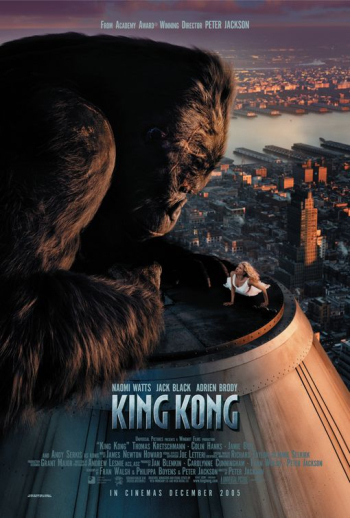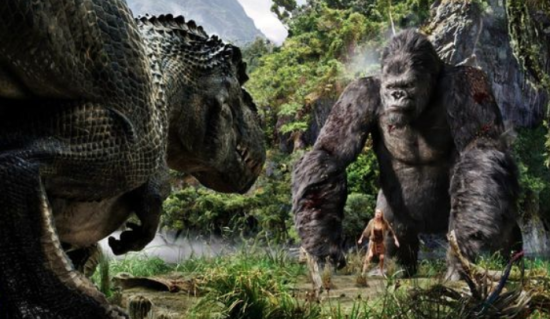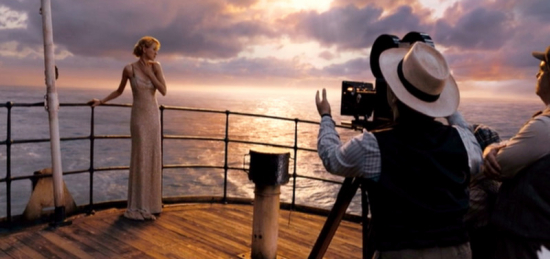The Heart Of The Beast
Peter Jackson Overshoots His King Kong Remake
By Cole Smithey
 As a rule, remakes never exceed an original film’s impact. With “King Kong” director Peter Jackson scoffs at that truism but diminishes the beguiling effect of his success by allowing the momentum of the story to falter during each protracted act.
As a rule, remakes never exceed an original film’s impact. With “King Kong” director Peter Jackson scoffs at that truism but diminishes the beguiling effect of his success by allowing the momentum of the story to falter during each protracted act.
The result is a very good three-hour movie that could well have been a truly great if 30 minutes were cut out. With the aid of a phenomenal special effects crew, and dynamic performances from its talented cast, “King Kong” is a spectacle movie with heart.
The fact that the film’s enormous seat of passion is held by a 25-foot ape is the crux of the whole story. Andy Serkis (“The Lord of the Rings” trilogy) does dual duty as a ship’s cook, on the voyage to the mysterious “Skull Island,” and as Kong’s interior aspect. We witness Kong’s intense germinating love for Ann Darrow (magnificently played by Naomi Watts) in the giant ape’s facial expressions and instinctual body movements. Such details are astonishing for their naturalistic purity. “King Kong” is a rare film that would be improved with a “director’s cut” that excised rather than added.
Peter Jackson wins kudos for not only keeping Merian C. Cooper’s and Ernest B. Schoedsack’s King Kong story firmly rooted in its depression-era milieu, but for filming it with earnest nods to that period’s style of lighting and visual composition.
There are many times in the movie when you feel a charge of recognition shoot up your spine as Jackson captures the same visual tone of films made during the ‘30s. Jackson plays with the filmic medium like a virtuoso painter able to reference and extemporize on visual motifs while slipping in subtle surprises to excite the senses. It’s clear that Jackson has thought long and hard over the way he would remake “King Kong,” perhaps a little too long and hard.
Jackson’s version retains the pulpy feel of the 1933 original. Jack Black flexes his acting muscles as the reckless film producer/director Carl Denham who sees defeat as something always fleeting. Black single-handedly manipulates the film’s underlying comic tone. He alleviates some of its excessive violence with a characterization that spins in a parallel orbit to that of Howard Hughes.
The film occurs around the same time that Hughes made “Hell’s Angels.” “King Kong” hits a fever pitch of weird energy when Denham and his more-hijacked-than-hired cargo ship of passengers make a crash landing on Skull Island.
Carl’s company go ashore with the ship’s Captain (Thomas Kretschmann) and crew to discover a violent tribe of voodoo-trance natives already preparing to offer up Ann as a sacrifice to the giant ape that lives behind the island’s walled off center. These natives aren’t just vicious; they are freaky with a capital “F.”

The movie shifts into the territory of “Jurassic Park” once King Kong captures Ann in his giant palms. A dinosaur stampede lays the narrative groundwork for the film’s centerpiece battle between Kong and a trio of T-Rexes, with Ann being tossed between the ape’s hands like an agreeable Barbie Doll.
It’s in the aftermath of Kong’s stupendous battle that Ann’s heart is driven ape by the big gorilla. However excessive the escalating battle scenes with prehistoric creatures may be, they firmly support the story. Kong’s desire to protect Ann sets up their mutual romantic understanding, however tentative that might be.
Even though some of the CGI work is not as refined as you would expect, and the number of expendable ship’s crew members seems to imply more individuals than arrived on the island, Peter Jackson’s “King Kong” succeeds based on Naomi Watts’ palpable performance opposite Andy Serkis. Now, if only Peter Jackson will come to his senses and edit the film into a director’s cut that will uncover the masterpiece buried within.
Rated PG-13. 187 mins.









